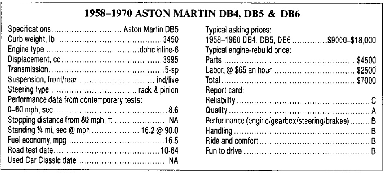 | 330 GT Registry |  |
1958-1970
Aston Martin
DB4, DB5 & DB6
Lets get one thing straight about the DB series of Aston Martins right away: Machine guns that pop out of the front turn signal lenses, pivoting taillights that release a stream of slippery oil and passenger ejection seats were not usual factory options.
No, these goodies were specially reserved for James Bond’s DB5. Before the movie Goldfinger, most Americans had never heard of Aston Martin. Indeed, many still haven’t. Not long ago I had the pleasure of driving one of Aston’s current models, a $150,000 Volante. Admiring the car, a New York City parking lot attendant told me that his father used to have an “Austin Martin,” only it was smaller and had a 4-cylinder engine.
Oh, well, it’s not surprising that an American wouldn’t know an Aston Martin from an Austin-Healey. After all, you’re just not likely to see one at the local shopping mall, which is part of the charm of owning an Aston Martin. General Motors puts out as many cars in a day as Aston Martin has built in 72 years. Of the models we’re discussing here, less than 4000 were built, including 1119 DB4s, 1150 DB5s and 1575 DB6s.
In Great Britain, however, Aston Martin Lagonda Ltd is a revered institution like Wimbledon, Big Ben and warm beer.
In the same spirit that Italians regard Ferrari today, the Brits remember when Aston Martin carried the Union Jack to glory in 1959 by winning the World Sports Car Championship. Peter Sprague, an American who rescued the company from bankruptcy in 1975, tells how people stopped on the sidewalks and actually applauded when a prototype Lagonda made its first appearance on the streets of London in 1976. England may have lost its empire, but it wasn’t going to lose Aston Martin.
In fact, England nearly lost Aston Martin several times over the decades, as the company’s financial position went up and down. In addition to its problems in the mid-Seventies, the company fell bankrupt in the mid-Twenties and mid-Forties as well, each time to be saved by a new owner. Perhaps the most renowned was Sir David Brown, a wealthy industrialist who owned the company from 1947 to 1972. In R&T’s 1964 test of the DB5 (the DB standing for David Brown, of course) it was mentioned that Aston Martin represented a mere 3 percent of Brown’s gross receipts from his business empire and that the company was “nothing much more than a labor of love.” One of Sir David’s buddies is reputed to have asked to buy a car at cost. Brown readily agreed, because that meant a price substantially over list.
All this background isn’t merely corporate trivia. It’s essential to understanding the nature of the cars. As with Enzo Ferrari, David Brown’s passion for racing was reflected in his road cars. The DB4, DB5 and DB6 are high-velocity vehicles of the first order. A DB4 can zip from 0 to 100 mph and stop to a standstill (thanks to 4-wheel Dunlop disc brakes) all in just 27 seconds, a statistic unmatched by any production car until the coming of the Cobra. And like most race cars, these Astons give the impression of being a man’s machine: heavy, powerful, visceral. “A sensitive woman driver should feel rejected,” we said in our 1966 test of the DB6. This, despite the fact that the DB6 had such luxury-car amenities as air conditioning and electric window lifts. The late DB4s, all the DBSs and even DB6s had the option of an automatic transmission.
The dohc 6-cylinder engine used in the cars is a direct descendant of the engine that ran in Le Mans in 1957. On the out side it looks like a Jaguar 6 with its SU carburetors and polished-aluminum cam covers. But as any competent mechanic who’s familiar with both engines knows, the Aston’s is built to much stricter tolerances, which means it’s trickier to rebuild.
The DBs use a steel platform frame and a rather Byzantine network of steel tubes to support the beautiful aluminum body work. This construction system, based on Supperleggera patents developed by Carrozzeria Touring of Milan, gives an especially rigid structure.
Moreover, the system lent itself to the hand craftsmanship for which Aston Mar tin has become famous. Aston made the DB series the old-fashioned way, with tinsnips and mallets. Even present-day Astons are genuine handmade cars, from the chassis and body to the engine.
Of course, such quality doesn’t come cheap. David Brown sold the DB6 for about $15,000 in 1965. Twenty years later, a new V-8 coupe costs about $100,000 and the parts for all Astons are comparably priced. As a result of expensive parts, a lot of relatively inexpensive DB-series As- tons were terribly neglected, and some body buying one today is often stuck with the bill for that neglect.
The differences between the DB4, DB5 and DB6 models are primarily ones of refinement rather than dramatic change. Early DB4 3670-cc engines tended to overheat and were also loath to hold their oil pressure. The problems were mitigated with various engine modifications in the later DB4s and were resolved when the engine was redesigned as a 3995-cc unit for the DB5. Early DB4s also suffered gearbox and clutch troubles.
While the major differences between the DB4 and DB5 are mechanical, the changes between the DB5 and DB6 are mostly in the body. The DB6’s wheelbase was increased, and though the DB4 and DB5 have small rear seats, the DB6 is a real 4-passenger car. The tail end of the DB6 also received a modest spoiler lip that many Aston fans feel detracts from the car’s classic lines.
Astons aren’t cheap to run. But they are high performance grand touring cars steeped in motoring history, handmade by true craftsmen and oozing with upper-crust British class—and all for the price of a new Mazda RX-7.

ROAD & TRACK October 1985
Copyright 1985, CBS, Inc.
